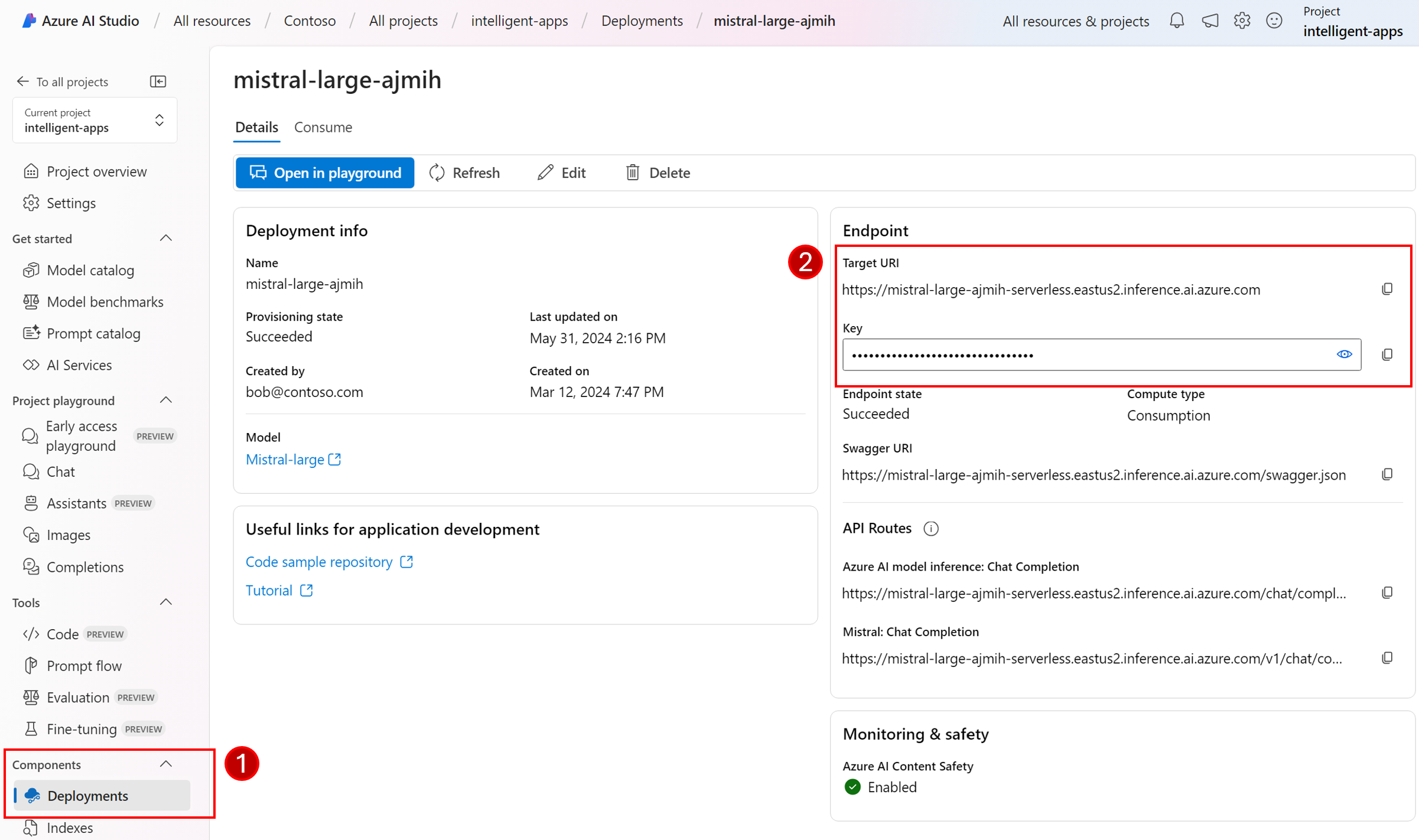你当前正在访问 Microsoft Azure Global Edition 技术文档网站。 如果需要访问由世纪互联运营的 Microsoft Azure 中国技术文档网站,请访问 https://docs.azure.cn。
使用 Semantic Kernel 和 Azure AI Foundry 开发应用程序
在本文中,你将了解如何将 Semantic Kernel 与从 Azure AI Foundry 门户中的 Azure AI 模型目录部署的模型配合使用。
先决条件
一个 Azure 订阅。
Azure AI 项目,如在 Azure AI Foundry 门户中创建项目中所述。
已部署一个支持 Azure AI 模型推理 API 的模型。 在此示例中,我们使用
Mistral-Large部署,但你可以使用自己偏好的任何模型。 若要使用 LlamaIndex 中的嵌入功能,你需要一个像cohere-embed-v3-multilingual这样的嵌入模型。- 可以按照将模型部署为无服务器 API 中的说明进行操作。
已安装 Python 3.10 或更高版本,包括 pip。
已安装 Semantic Kernel。 可以使用以下方法执行此操作:
pip install semantic-kernel在此示例中,我们使用 Azure AI 模型推理 API,因此我们安装相关的 Azure 依赖项。 可以使用以下方法执行此操作:
pip install semantic-kernel[azure]
配置环境
若要使用部署在 Azure AI Foundry 门户中的 LLM,你需要终结点和凭据来连接到它。 请按照以下步骤从想要使用的模型中获取所需的信息:
打开部署模型的项目(如果尚未打开)。
转到“模型 + 终结点”,并根据先决条件选择已部署的模型。
复制终结点 URL 和密钥。
提示
如果模型部署了 Microsoft Entra ID 支持,则不需要密钥。
在这种情况下,我们将终结点 URL 和密钥都放在以下环境变量中:
export AZURE_AI_INFERENCE_ENDPOINT="<your-model-endpoint-goes-here>"
export AZURE_AI_INFERENCE_API_KEY="<your-key-goes-here>"
配置完成后,创建一个客户端来连接到终结点:
from semantic_kernel.connectors.ai.azure_ai_inference import AzureAIInferenceChatCompletion
chat_completion_service = AzureAIInferenceChatCompletion(ai_model_id="<deployment-name>")
提示
客户端会自动读取环境变量 AZURE_AI_INFERENCE_ENDPOINT 和 AZURE_AI_INFERENCE_API_KEY 来连接到模型。 但是,还可通过构造函数上的 endpoint 和 api_key 参数直接将终结点和密钥传递给客户端。
也可在终结点支持 Microsoft Entra ID 的情况下,使用以下代码来创建客户端:
export AZURE_AI_INFERENCE_ENDPOINT="<your-model-endpoint-goes-here>"
from semantic_kernel.connectors.ai.azure_ai_inference import AzureAIInferenceChatCompletion
chat_completion_service = AzureAIInferenceChatCompletion(ai_model_id="<deployment-name>")
注意
使用 Microsoft Entra ID 时,请确保已通过该身份验证方法部署终结点,并且你拥有调用它所需的权限。
Azure OpenAI 模型
如果使用 Azure OpenAI 模型,可使用以下代码创建客户端:
from azure.ai.inference.aio import ChatCompletionsClient
from azure.identity.aio import DefaultAzureCredential
from semantic_kernel.connectors.ai.azure_ai_inference import AzureAIInferenceChatCompletion
chat_completion_service = AzureAIInferenceChatCompletion(
ai_model_id="<deployment-name>",
client=ChatCompletionsClient(
endpoint=f"{str(<your-azure-open-ai-endpoint>).strip('/')}/openai/deployments/{<deployment_name>}",
credential=DefaultAzureCredential(),
credential_scopes=["https://cognitiveservices.azure.com/.default"],
),
)
推理参数
可以使用 AzureAIInferenceChatPromptExecutionSettings 类配置推理的执行方式:
from semantic_kernel.connectors.ai.azure_ai_inference import AzureAIInferenceChatPromptExecutionSettings
execution_settings = AzureAIInferenceChatPromptExecutionSettings(
max_tokens=100,
temperature=0.5,
top_p=0.9,
# extra_parameters={...}, # model-specific parameters
)
调用服务
让我们先使用简单的历史聊天记录调用聊天完成服务:
提示
Semantic Kernel 是一个异步库,因此你需要使用 asyncio 库来运行代码。
import asyncio
async def main():
...
if __name__ == "__main__":
asyncio.run(main())
from semantic_kernel.contents.chat_history import ChatHistory
chat_history = ChatHistory()
chat_history.add_user_message("Hello, how are you?")
response = await chat_completion_service.get_chat_message_content(
chat_history=chat_history,
settings=execution_settings,
)
print(response)
或者,可以从服务流式传输响应:
chat_history = ChatHistory()
chat_history.add_user_message("Hello, how are you?")
response = chat_completion_service.get_streaming_chat_message_content(
chat_history=chat_history,
settings=execution_settings,
)
chunks = []
async for chunk in response:
chunks.append(chunk)
print(chunk, end="")
full_response = sum(chunks[1:], chunks[0])
创建长时间运行的对话
可以使用循环创建长时间运行的对话:
while True:
response = await chat_completion_service.get_chat_message_content(
chat_history=chat_history,
settings=execution_settings,
)
print(response)
chat_history.add_message(response)
chat_history.add_user_message(user_input = input("User:> "))
如果要流式传输响应,可使用以下代码:
while True:
response = chat_completion_service.get_streaming_chat_message_content(
chat_history=chat_history,
settings=execution_settings,
)
chunks = []
async for chunk in response:
chunks.append(chunk)
print(chunk, end="")
full_response = sum(chunks[1:], chunks[0])
chat_history.add_message(full_response)
chat_history.add_user_message(user_input = input("User:> "))
使用嵌入模型
配置环境与上述步骤类似,但使用 AzureAIInferenceEmbeddings 类:
from semantic_kernel.connectors.ai.azure_ai_inference import AzureAIInferenceTextEmbedding
embedding_generation_service = AzureAIInferenceTextEmbedding(ai_model_id="<deployment-name>")
以下代码演示如何从服务中获取嵌入项:
embeddings = await embedding_generation_service.generate_embeddings(
texts=["My favorite color is blue.", "I love to eat pizza."],
)
for embedding in embeddings:
print(embedding)
